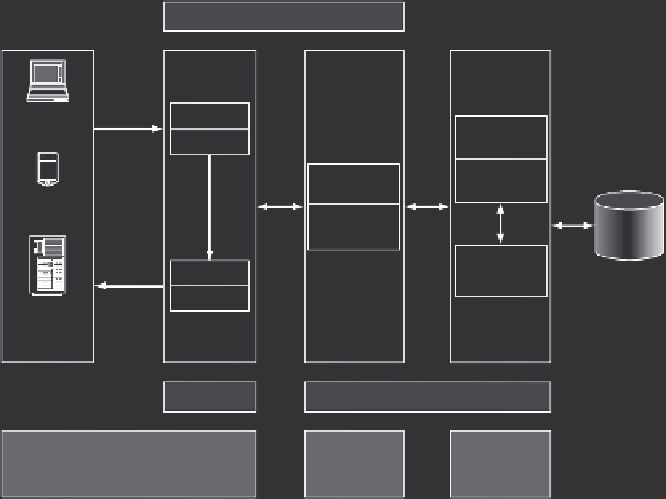Database Reference
In-Depth Information
Controller
Web
browser
Servlet
Controller
Entity bean/
Java classes
HTTP
request
Business
objects
Session
bean
Wireless
device
Service
components
RMI
RMI/
local
inter-
face
Database
JDBC
Data access
objects
JSP
View
HTTP
response
B2B Web
Service
client
View
Model
User
interaction
architecture
Service-
based
architecture
Business
object
architecture
Figure 11. 3
MVC and enterprise Application Architecture.
View does not contain the source of data and relies on the model to furnish the relevant data.
When the model updates the data, it notifies as also furnishes the changed data to the view so that
it can re-render the display to the user with the up-to-date data and correct data.
The controller channels information from the view on the user actions for processing by the
business logic in the model. Controller enables an application design to flexibly handle things such
as page navigation and access to the functionality provided by the application model in case of
form submissions. Thus, controller provides an isolation point between the model and the view,
resulting in a more loosely coupled front end and back end.
Figure 11.3 gives a complete picture of how objects in the MVC architecture are mapped to
the reference architecture in J2EE.
11.2.3.4 Overview of J2EE Technologies
These can be subdivided into three main categories, namely, component services, horizontal ser-
vices, and communication services.
11.2.3.4.1 Component Services
These services assist in expediting and simplifying the development of the enterprise applications.
They insulate the resulting applications from the underlying J2EE APIs.
11.2.3.4.1.1 JavaServer Pages (JSP) —
As discussed in MVC architecture previously, the
objective is to separate the presentation and content from the application logic, with the presenta-
tion and content contained in the JSP. JSP is similar to server-side scripting technology, except that

